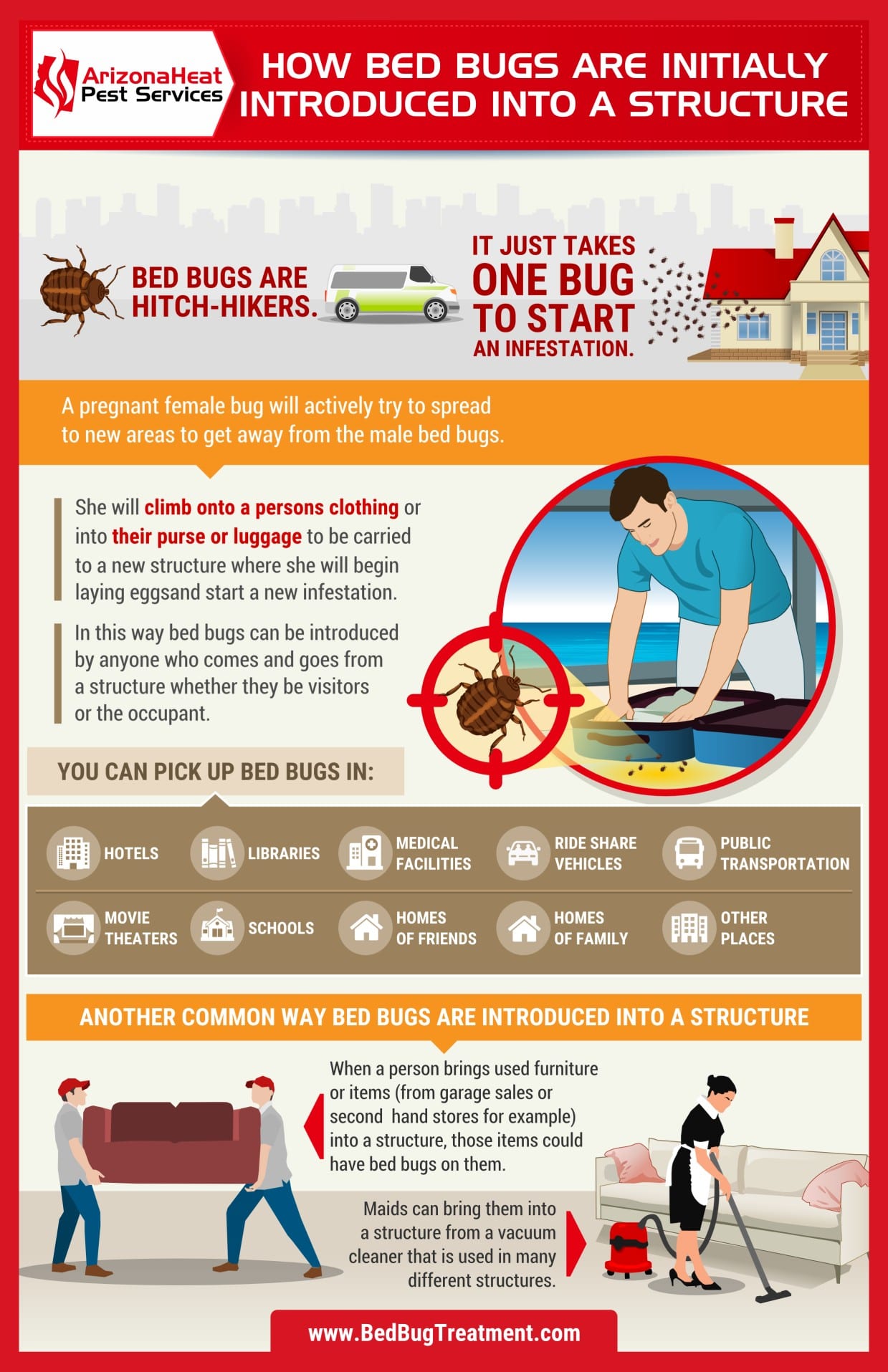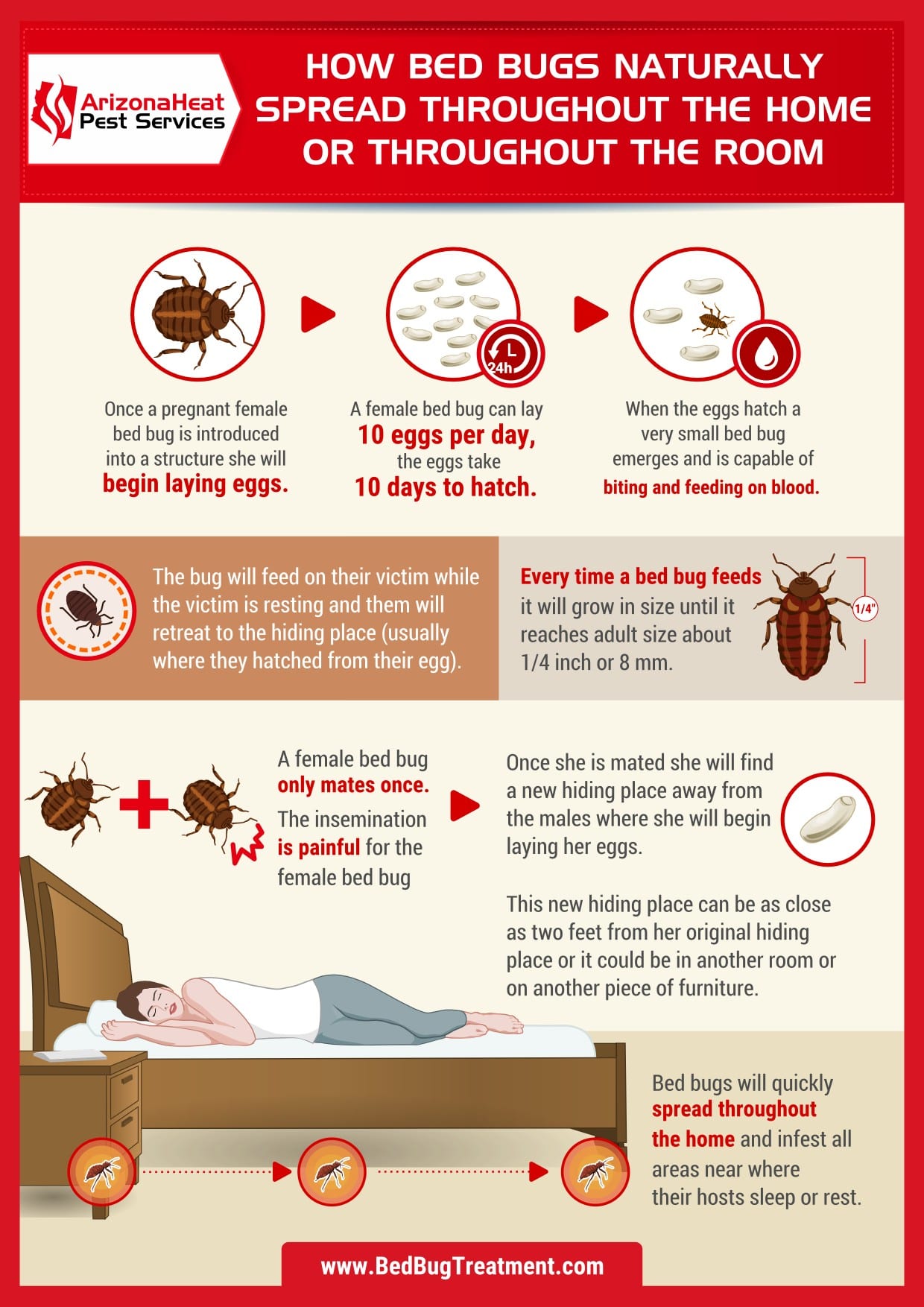“It takes only about 10 days for bed bug eggs to hatch, with each egg that is female having the capability to go on and lay up to 500 more eggs. Within the period of a month, your entire home can be infested with thousands of bed bugs. Homes that have endured bed bug infestations for longer than three months can expect to have the bugs in amounts exceeding 30,000″
How do you get bed bugs?
Bed bugs are hitch hikers. They spread from structure to structure on a person’s clothing or belongings. Take a look at this infographic that explains how you can get bed bugs.
How do bed bugs spread?
When the female bed bug is introduced into the structure she will start laying eggs right away. The place where she lays the eggs is called the nesting site. When the eggs hatch the babies will seek a blood meal right away. Every time the bug eats, it sheds its skin and grows in size. Once the males and females are large enough to mate they will begin spreading throughout the room and into other rooms. Check out the infographic below to learn more about how bed bugs spread.
What does a bed bug look like?
These pests have 6 legs, are oval in shape, brown/reddish brown in color and approximately 4mm in length as adults. When they are still juveniles, beg bugs are translucent and very small, making them difficult to spot. During all stages of their life, the body is very flat, almost paper thin. When the bed bug has fed it will become darker brown/reddish in color and will appear more engorged and elongated. Check out our photos & videos to get a better look.
Bed Bug History
The Scientific name for the garden-variety bed bug is Cimex Lectularious. In Spanish they are known as Chinches De Cama. In the past, they’ve also been called “chinch” or “red coats.” Bed bug are generally referred to as a human parasite. Miriam-Webster Dictionary defines a parasite as: “An animal or plant that lives in or on another animal or plant and gets food or protection from it.”
Although the definition above insinuates that bed bugs are not a parasite, they are in fact. They don’t live under or on the skin of a human being, but they do live in what is called the human “nest.” When pest control specialists talk about bed bugs, many of them refer to them as nest pests. These little bugs will hide in furniture, corners of your home in the hallways, wall outlets, bedroom linens, and more. They don’t typically feed off humans until they are at rest, which is why they typically attack at night. Humans have taken the top spot on a bed bug’s favorite food, but they can also live off pets and other warm-blooded animals.
Just because bed bugs tend to feed on humans at night, this does not mean they are nocturnal. Studies have shown that bed bugs will feed during any part of the day or night. Even if they are living in a room and the lights are on, if they find a human or some other type of feeding option, they will take advantage of it. With this in mind, just because a person works nights and sleeps during the day, it’s still possible for them to get attacked by bed bugs.
A single female can lay up to 500 eggs, with each one hatching and then mating with other bugs. It can take only one generation of bugs to multiply into thousands within a short period of time. There is no type of standard or social barrier that exists for bed bugs — they do everything they can to invade any type of space they come across. Whether you’re settling into a home 100 years old or one just recently built, bed bugs can become a problem if you’re not careful.
What is it like to have bed bug bites?
Bed bug bites are usually red and itchy. They can be quite aggravating and are similar to mosquito bites. They usually occur in groups or lines, sometimes raised or welt-like. There has also been studies performed that have confirmed these bugs can transmit Chagas disease. Visit our bed bug bite page to learn more.
What is a bed bug’s lifecycle like?
Once a single bed bug makes into your home, it won’t take long for a full-blown infestation to occur. Bed bugs have short lifecycles; however, the food and blood available to them will ultimately determine how much they are able to reproduce. It’s not uncommon for bed bugs to have higher rates of multiplication during the summer rather than the winter, but they can still reproduce all year long. After a female has mated she will continue to lay eggs for the remainder of her life without another mating. The mated female will then run away from the current nest and create a new nest for herself nearby.
It takes only about 10 days for bed bug eggs to hatch, with each egg that is female having the capability to go on and lay up to 500 more eggs. Within the period of a month, your entire home can be infested with thousands of bed bugs. Homes that have endured bed bug infestations for longer than three months can expect to have the bugs in amounts exceeding 30,000.
Where do bed bugs like to live?
Just like humans, bed bugs prefer spaces that are mildly warm and have lots of food. They are also well known for attacking their hosts during the middle of the night, but this doesn’t have anything to do with it being dark. Instead, it has more to do with the fact that hosts are normally still when they are sleeping, which makes the feeding sessions much simpler to carry out. When they don’t live on bed linens and humans, they prefer cracks and crevices in your home, as well as your clothes and any personal belongings, such as luggage and purses.
Can I attract bed bugs when I’m camping?
There are many people who believe they pick up bed bugs while camping. Truth is, though, the infiltration is being caused by the people we’re around, or the RVs in which they were camping. Bed bugs don’t live outdoors. They live indoor and hitch rides from one home to another by clinging to luggage, purses, clothing, hair, etc.
What are bat and bird bugs?
Bat and bird bugs are very similar to bed bugs, but their hosts are completely different. As you have probably assumed, bat bugs feed on bats, while bird bugs prefer to feed on birds. These types of bugs do live outdoors unlike bed bugs, however if the nest population grows too large they will feed on humans if necessary, so it’s imperative to make sure your home is treated for them.
What are different types of evidence for the presence of bed bugs?
There are many signs to look for when inspecting for bed bugs. Here are but a few:
- Musty smell
- You can see the bugs
- Small black spots on bed linens; you’ll also want to look for them on furniture, walls, blinds and curtains
- Small black spots on the ceiling


